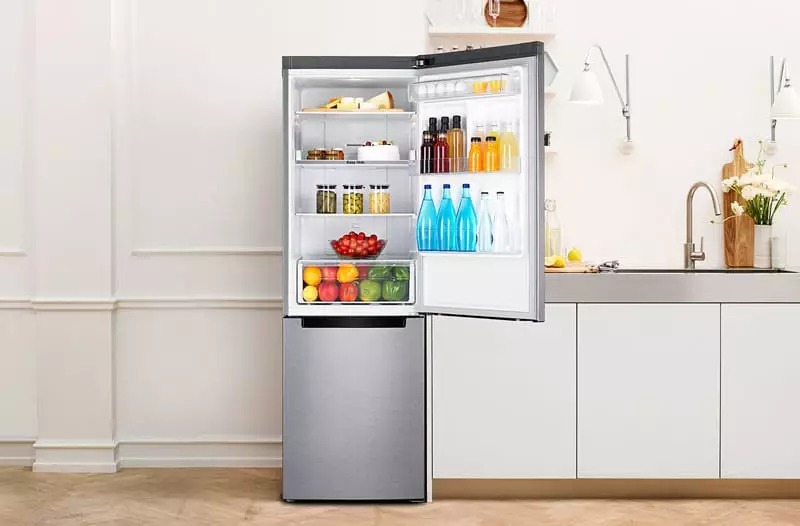Temperature in the refrigerator for storing food
Today, the presence of a refrigerator in the kitchen will surprise no one. These household appliances have long ceased to be a luxury item. However, many of us have never asked the question: what temperature should the refrigerator be? Freezer? Or in the refrigerator door? Meanwhile, the service life of this unit directly depends on how accurately the temperature regime is maintained.

Types of refrigerators
Perhaps for a simple housewife there is no difference in what type of unit is in her kitchen. The main thing is to cope with the function of storing (cooling) products, if possible, do not take up much space and fit into the interior of the kitchen.

The main division of refrigeration units is based on the cooling principle. Distinguish:
- Compression;
- Thermoelectric;
- Absorption;
- With vortex coolers.
Refrigerators are also subdivided into single-chamber and two-chamber. Immediately, we note that the number and location of chambers directly affects the efficiency of using the unit.

Single-chamber models mean that both the refrigerator and the freezer are located in the same compartment. They are separated only by a symbolic partition, and they have a common door. The freezer is located either below or above the refrigerator compartment. There are models in which the presence of a freezer is not provided at all, even a very small one.

In single-chamber refrigerators, one compressor is installed, and even that one usually does not work at full capacity. Freezing takes a very long time. And due to the fact that the door constantly opens and closes, icing quickly forms on the walls and you need to defrost it often. The No Frost system makes things a little easier.

Two-chamber versions have two independent compartments, each of which is equipped with its own door. In this version, there are two compressors and the No Frost system can also be installed on each compartment.

Temperature range for refrigerator
First, let's decide on the answer to the question: why do you even need to know how many degrees are in the refrigerator? There are a number of reasons:
- This will prevent food spoilage;
- Reduces the number of unit defrosts;
- Will extend the service life of household appliances;
- Reduces the number of defrosts;
- And it will significantly increase the shelf life of products.

Let's note right away that the temperature in different zones of the refrigerator differs. On average, the optimal temperature in the refrigerator should range from +3 to +9 degrees Celsius.

So, near the rear wall of the unit, next to the freezer, the temperature ranges from +1 to +3 degrees. On the central shelves - from +3 to +5.

The lowest shelves are ideal for ready meals. It is here that the highest indicator is reached - up to +9 degrees. Almost every modern refrigerator model is equipped with plastic boxes and containers to make it easier to store food.

The "warmest" place in the refrigerator (if such a definition is appropriate at all) is the door. In it, the maximum temperature indicator is up to +10 degrees.

The optimum temperature for a freezer in a refrigerator is -18 degrees Celsius. But in this case, a number of factors affect the temperature. For example, the degree of filling plays an important role in freezing. The more food there is in the freezer, the less freezing it will be. Therefore, if a "full house" is not expected in your freezer, set the temperature not lower than -14 degrees.

Some models of refrigerators have a special function "Fast Freeze" or "Super Freeze". This means you can freeze food for several hours at -24 to -30 degrees. According to the generally accepted opinion, it is with quick freezing that it is possible to preserve the beneficial properties of products in the best way.
Why you need to measure the temperature in the refrigerator
Most often, users do not think how many degrees Celsius are in the refrigerator. But in vain. Perhaps, having carried out elementary measurements, and having determined the indicators, it will turn out to improve the performance of household appliances.
Usually, such measurements are resorted to in the following cases:
- When doubts arise about the health of the refrigerator;
- If the selected mode is not suitable for some specific products;
- Or just to make it clear: how many degrees are in one or another compartment of the refrigerator.

How to measure the temperature in the refrigerator
Modern models are equipped with built-in thermometers, so it is very easy to determine how much the refrigerator copes with its direct duty.

If we are talking about older generation refrigerators, then you will have to do a number of simple manipulations.
- Take a thermometer without damage;
- Put it on a dry plate;
- Place the plate with the thermometer in a specific area (in the freezer, on the top or bottom shelf);
- Leave with the door closed for 10 minutes;
- Take out and see the indicator.

Useful tips for operating your refrigerator
While much depends on the original functionality of your machine, it is up to you to extend its life and improve performance.
- Do not put hot food in the refrigerator (especially for liquid dishes - soups);
- Do not keep the door open for an unreasonable length of time;
- Clean up the area where fresh vegetables and fruits are kept more often;
- Do not install heavy-duty cooling indicators in two chambers at once, this will shorten the life of the refrigerator;
- It is better to freeze fresh berries and fruits in special sealed bags, then, in case of unexpected defrosting, the food will not spoil the refrigerator;
- Defrost the refrigerator regularly. The frequency of such actions depends on the basic functions of each specific model.

Obviously, understanding the temperature regime of your own refrigerator is not a whim, but an opportunity to make the operation of the unit as efficient and safe as possible. Thus, you can save not only time and effort, but also money.

VIDEO: Setting the temperature in the refrigerator.













